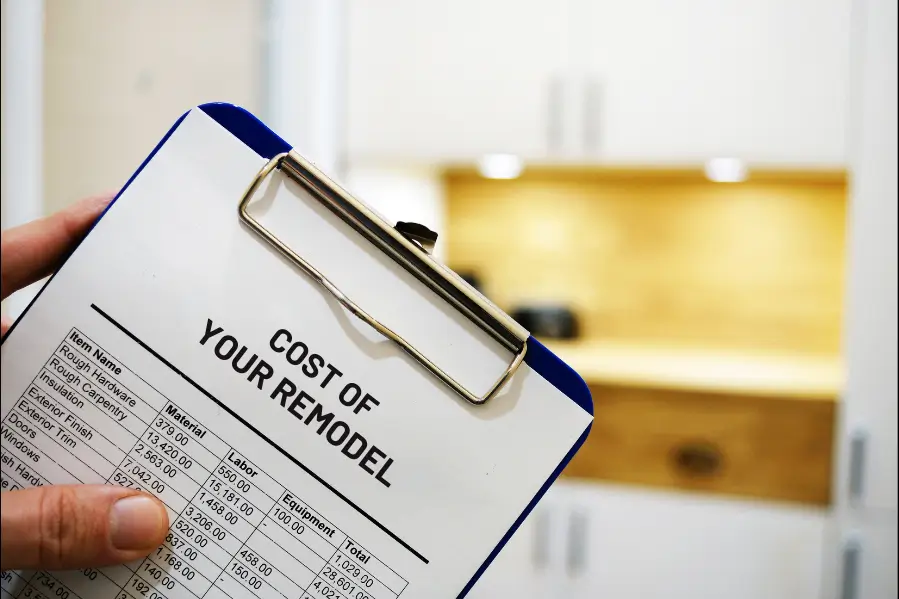When you’re getting ready to renovate your home, one of the big questions you’ll face is how to pay for it. Whether you’re remodeling a new kitchen, a cozy home office, or a luxurious bathroom, figuring out the money side of things is crucial.
Luckily, there are different ways to finance your home makeover. You can use the equity you’ve built up in your home or explore other options like personal loans, credit cards, etc. Each option has its pros and cons, and it’s essential to understand them before making a decision.
In this guide, we’ll discuss the various ways to finance your home remodel and help you determine which option might be best for you based on your situation and goals. So, let’s get started!
Part: 1 Assess the Cost of Your Remodel

When you are planning a home remodel, the first step is to ask yourself.
- How big or small will your renovation project be?
- Is it minor updates like painting a room, replacing fixtures, or major overhauls like redoing an entire kitchen or adding a new room to your house?
Another thing to consider is whether you’ll hire a contractor to do the work or tackle some (or all) of it yourself. Hiring a contractor can save you time and hassle, but it usually costs more money.
Estimate the Costs
Once you’ve figured out what you want to do, the next step is to estimate how much it’s going to cost. Here’s how you can do that:
- Get quotes from contractors: Contact several contractors and ask them for detailed quotes for the work you want done. This will give you an idea of how much the project will likely cost. Smart Remodeling LLC offers free estimates with no commitment to book services.
- Plan for unexpected expenses: Even with thorough planning, unforeseen circumstances can arise during your remodeling project. It’s a good idea to set aside some extra money as a contingency fund to be prepared. This is usually around 10-20% of your total budget.
- Budget for everything: When estimating costs, remember to include everything you’ll need to pay for. This includes materials, labor, permits, and any other fees or expenses that might come up along the way. So, plan your budget thoroughly.
Part: 2 Evaluate Your Financial Situation
Now after you assess your remodeling project and get a cost estimate for it, let’s see what you have in your bank. It’s essential to take a close look at your financial situation. Here are some key factors to consider when you are evaluating your financial situation.
1. Review your Credit card
Your credit score is like a grade that shows how well you manage your finances. Lenders use it to decide whether to give you a loan and what interest rate to offer you. The higher your credit score, the better the terms you’ll likely get on a loan.
To improve your credit score, focus on paying down any existing debt and avoiding taking on new debt.
2. Calculate Home Equity
Home equity is the difference between what your home is worth and how much you still owe on your mortgage. It’s an essential factor for certain types of home improvement loans, like home equity loans and home equity lines of credit (HELOCs).
To calculate your home equity, you’ll need to know your home’s current value. You can use recent home sales data in your area or hire a professional appraiser to get an accurate estimate.
3. Understand Your Debt-to-Income Ratio:
Your DTI ratio evaluates the proportion of your monthly income that goes towards servicing your debts. Lenders examine this ratio to evaluate how well you can manage new debt. A lower DTI ratio is typically preferred because more income is available to cover your debt payments.
Part: 3 Explore Different Financing Options

Now comes the main part: finding different financing options for your home remodel. Let’s explore this in detail.
1. Home Equity Loans & HELOC
Home equity loans and home equity lines of credit (HELOCs) are ways to borrow money using the equity in your home as collateral. Here’s a breakdown of each:
Home Equity Loans
This loan is best for Homeowners who have a clear idea of how much their renovation project will cost, as it is fully funded at once.
A home equity loan gives homeowners an upfront lump sum of money, which they can use for home improvement projects. These loans are repaid over a fixed term ranging from five to 30 years.
Home equity loans offer predictable monthly payments, which means you will know how much you’ll pay each month. This makes budgeting easier.
HELOC (Home Equity Line of Credit)
Best for: Ongoing projects where the exact costs are not clear. It allows homeowners to access funds as required.
A HELOC functions like a credit card. You can draw money whenever you need, up to a certain limit. Repayment terms are usually based on the amount borrowed, with minimum payments required.
HELOCs commonly feature different interest rates, which means monthly payments may fluctuate over time. Remember that there might be additional expenses at the beginning, and if you can’t repay what you borrow, you could risk losing your home.
2. Cash-Out Refinancing
Cash-out refinancing is a financial strategy where you replace your existing mortgage with a new one that’s larger than what you currently owe. The difference between the two loans is given to you in cash at closing.
This extra money can be used for various purposes, such as home improvements, debt consolidation, or other financial needs. Remember that because it’s a secured loan, your home serves as collateral, meaning if you fail to make payments, you could risk losing your home.
Pros
- Lower your monthly mortgage payment.
- Switch from an adjustable rate to a fixed-rate loan.
- Secure a lower interest rate than your current mortgage.
Cons
- You’ll owe more money with a bigger loan.
- Need good credit to qualify.
- It’s only worth it if you can get a lower rate and handle a shorter repayment term.
3. Personal Loans
A personal loan is a type of loan that can help homeowners finance projects quickly without the need for collateral like a home equity loan. Unlike home equity loans, which require lengthy underwriting and appraisal processes, these loans are typically funded within a week.
Personal loan interest rates generally range from 6% to 36%, which may be higher than home equity options but lower than some credit cards.
Repayment terms for personal loans usually range from two to seven years, though some lenders offer terms of up to 12 years for home improvements.
When It’s Best: Personal loans are ideal for situations where you need immediate funding, such as urgent repairs and projects you want to kick-start promptly. Additionally, they can be a suitable choice for larger projects when borrowing against your home’s equity is challenging.
4. Government Loans and Grants
Government loans are financial assistance programs the government provides to help individuals with various needs. These loans often come with favorable terms and conditions compared to loans offered by private lenders.
Some common types of government loans are given below:
| Loan/Grant Type | Eligibility |
|---|---|
| FHA 203(k) Rehabilitation Loans | First-time homebuyers |
| VA Renovation Loans | Veterans and active-duty military members |
| Home Improvement Grants | Income-specific or project-specific applicants |
Part: 4 Compare the Financing Options
In this section, we need to compare different financing options based on several key factors:
Interest Rates and Terms
Look at whether the rates are fixed or variable and the length of the loan term.
- Fixed rates stay the same throughout the loan term, giving you stability. Variable rates might start lower but can rise later on.
- Short-term loans have bigger payments per month but end up costing less in total interest.
- On the other hand, long-term loans have small monthly payment but accumulate more interest over time.
Monthly Payments and Total Costs
Then, calculate how much you’ll pay each month for each option and consider the total cost over the loan period. Make sure the monthly payments fit your budget without causing financial strain.
Fees and Penalties
Beware of origination fees, closing costs, and penalties for paying off your loan early. These extra expenses can impact the affordability of your financing choice.
Part: 4 Make the Final Decision
When making the final decision, it’s essential to consider whether the financing option aligns with your long-term and short-term financial goals. Choose an option that fits your monetary strategy and ensures affordability and sustainability.
Excited for Your Home Remodeling – Choose Your Renovation Partner
Excited to remodel your home? Meet Smart Remodeling LLC, your ultimate renovation partner. We specialize in both home and commercial remodeling and offer personalized solutions tailored to your needs in the Houston community.
With our award-winning services and commitment to excellence, we’ll turn your renovation dreams into reality. Get ready to transform your space with Smart Remodeling Company.
Part: 5 Conclusion
Financing a home remodel can be complex, but with the proper knowledge and preparation, you can find the best option for your needs. Thoroughly research and plan your project and consult with financial professionals to ensure a successful remodel.






